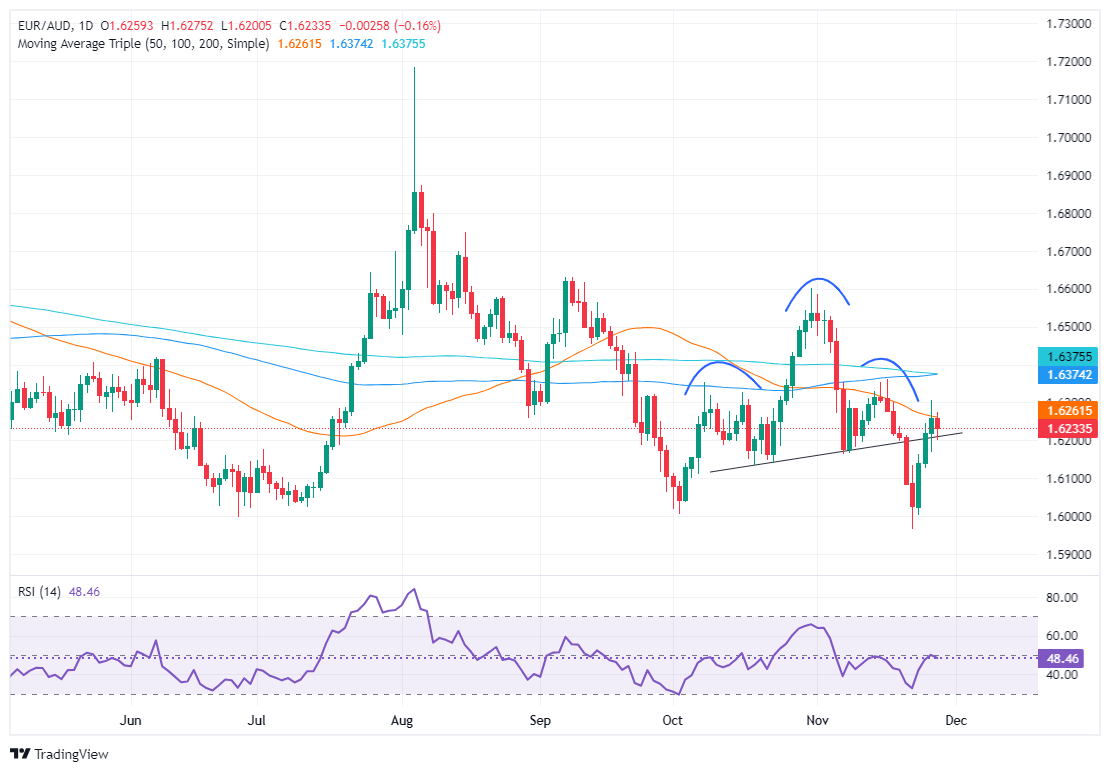- Analytics
- News and Tools
- Market News
- EUR/AUD Price Forecast: Slumps on bets for dovish ECB, bears eye 1.6200
EUR/AUD Price Forecast: Slumps on bets for dovish ECB, bears eye 1.6200
- EUR/AUD falls 0.20%, influenced by expectations of ECB policy easing.
- Technical indicators show a shift to neutral as EUR/AUD invalidates head-and-shoulders pattern.
- Key resistances await at 1.6254 (50-day SMA) and 1.6300; supports positioned at 1.6168 and 1.6003.
- Support level are seen at 1.6200, 1.6168 and 1.6003.
The Euro took a hit and dived against the Australian Dollar as traders seemed convinced that the European Central Bank (ECB) would lower borrowing costs at the upcoming meeting. The chances of the ECB cutting 50 basis points remain, as most Eurozone economies remain subdued. At the time of writing, the EUR/AUD trades were at 1.6231, down 0.20%.
EUR/AUD Price Forecast: Technical outlook
The EUR/AUD shifted from a downward to a neutral bias. Once prices cleared the head-and-shoulders (H&S) chart pattern’s neckline, the H&S was invalidated, indicating that buyers' bulls were gathering momentum.
On its way north, the EUR/AUD found acceptance at 1.6200 before extending its gains, but bulls must reclaim the 50-day Simple Moving Average (SMA) at 1.6254 to keep their hopes of testing 1.6300.
Conversely, if bears move in and push the EUR/AUD below the H&S neckline below 1.6200, this could pave the way for further downside. On that outcome, the first support would be the November 27 low of 1.6168, followed by the November 25 daily low at 1.6003.
EUR/AUD Price Chart – Daly
Euro FAQs
The Euro is the currency for the 19 European Union countries that belong to the Eurozone. It is the second most heavily traded currency in the world behind the US Dollar. In 2022, it accounted for 31% of all foreign exchange transactions, with an average daily turnover of over $2.2 trillion a day. EUR/USD is the most heavily traded currency pair in the world, accounting for an estimated 30% off all transactions, followed by EUR/JPY (4%), EUR/GBP (3%) and EUR/AUD (2%).
The European Central Bank (ECB) in Frankfurt, Germany, is the reserve bank for the Eurozone. The ECB sets interest rates and manages monetary policy. The ECB’s primary mandate is to maintain price stability, which means either controlling inflation or stimulating growth. Its primary tool is the raising or lowering of interest rates. Relatively high interest rates – or the expectation of higher rates – will usually benefit the Euro and vice versa. The ECB Governing Council makes monetary policy decisions at meetings held eight times a year. Decisions are made by heads of the Eurozone national banks and six permanent members, including the President of the ECB, Christine Lagarde.
Eurozone inflation data, measured by the Harmonized Index of Consumer Prices (HICP), is an important econometric for the Euro. If inflation rises more than expected, especially if above the ECB’s 2% target, it obliges the ECB to raise interest rates to bring it back under control. Relatively high interest rates compared to its counterparts will usually benefit the Euro, as it makes the region more attractive as a place for global investors to park their money.
Data releases gauge the health of the economy and can impact on the Euro. Indicators such as GDP, Manufacturing and Services PMIs, employment, and consumer sentiment surveys can all influence the direction of the single currency. A strong economy is good for the Euro. Not only does it attract more foreign investment but it may encourage the ECB to put up interest rates, which will directly strengthen the Euro. Otherwise, if economic data is weak, the Euro is likely to fall. Economic data for the four largest economies in the euro area (Germany, France, Italy and Spain) are especially significant, as they account for 75% of the Eurozone’s economy.
Another significant data release for the Euro is the Trade Balance. This indicator measures the difference between what a country earns from its exports and what it spends on imports over a given period. If a country produces highly sought after exports then its currency will gain in value purely from the extra demand created from foreign buyers seeking to purchase these goods. Therefore, a positive net Trade Balance strengthens a currency and vice versa for a negative balance.
© 2000-2025. All rights reserved.
This site is managed by Teletrade D.J. LLC 2351 LLC 2022 (Euro House, Richmond Hill Road, Kingstown, VC0100, St. Vincent and the Grenadines).
The information on this website is for informational purposes only and does not constitute any investment advice.
The company does not serve or provide services to customers who are residents of the US, Canada, Iran, The Democratic People's Republic of Korea, Yemen and FATF blacklisted countries.
Making transactions on financial markets with marginal financial instruments opens up wide possibilities and allows investors who are willing to take risks to earn high profits, carrying a potentially high risk of losses at the same time. Therefore you should responsibly approach the issue of choosing the appropriate investment strategy, taking the available resources into account, before starting trading.
Use of the information: full or partial use of materials from this website must always be referenced to TeleTrade as the source of information. Use of the materials on the Internet must be accompanied by a hyperlink to teletrade.org. Automatic import of materials and information from this website is prohibited.
Please contact our PR department if you have any questions or need assistance at pr@teletrade.global.
















